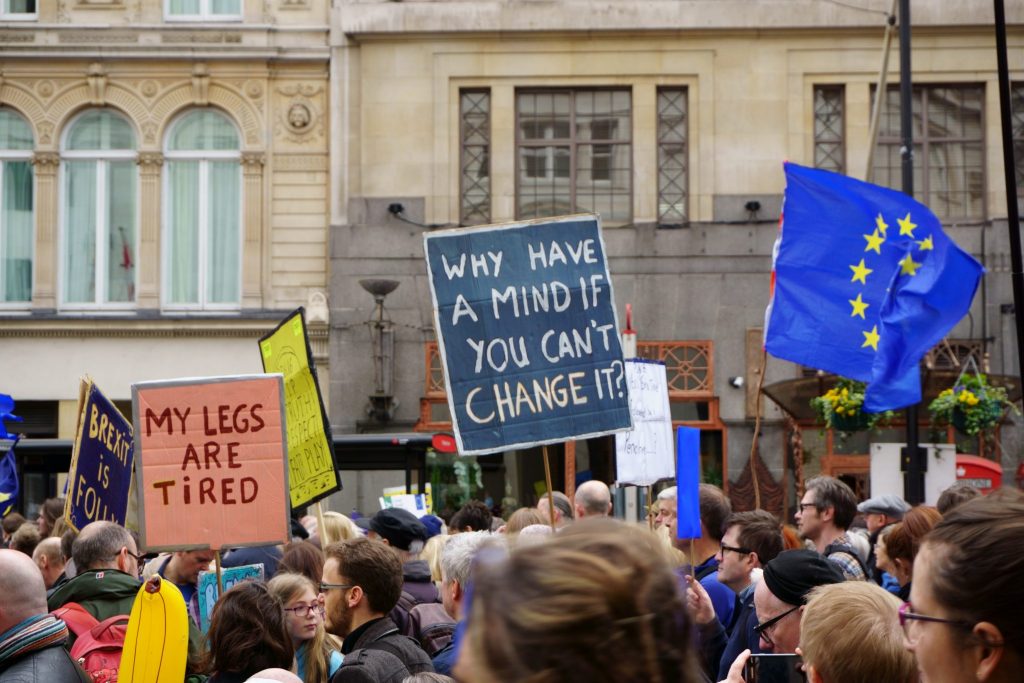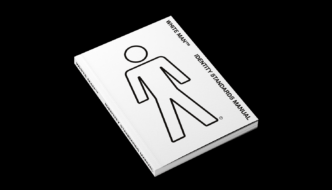Why Northern towns went blue over Brexit – and what that means for Black Lives Matter
June 30, 2020

Photo by Sandro Cenni on Unsplash
As peaceful anti-racism protests continue to divide public opinion nationwide and across the globe, it brings the national identity of Britain and its increasingly polarised voting base to mind. Did Brexit only capitalise on anti-immigration feelings we see manifesting in far-right counter protests? Did Brexit only finalise an ‘us’ and a ‘them’ between Leave voters, the majority of whom expressed concerns over immigration, and Remain voters? Is Britain now a land of right-wing backwards ‘thugs’ as some media dubs them and left-wing progressive ‘snowflakes’, whose identity is defined by disagreeing with one another?
The increasingly worrying polarisation of the vote over views on social issues and national identity has never been demonstrated more obviously than protests being met by counter protests. But arguably, warning signs of disillusion with political parties who do not represent their voters and stark differences of opinion have been prevalent for years. Brexit only confirmed the divide.
This country’s vote is unsurprisingly divided by age; over 65s were twice as likely as under 25s to vote Leave, and every time someone ages 10 years, they are 8% less likely to vote Labour. Somehow, the stereotype of left-leaning ‘virgin voters’ rings true even from the Attlee days – voters under the age of 50 voted majority Remain while those over 50 opted for Leave. As a result, young people are increasingly completely misrepresented in their government. As Leave voters, disproportionately represented by those older, die at 260,000 a year [YouGov], and Remainers reach voting age, Britain will increasingly be a majority Remain nation – even as Brexit has already happened.
So now we know that young people, generally, will vote Labour and vote Remain. But, why, outside the Twitter bubble dominated by its young left-wing base, did Labour falter? In the North, traditionally Labour constituencies fell like dominos to the Tories – Dewsbury, Bury, Wakefield. All these had majority Leave votes of 57%, 53%, 63% respectively. A strong Labour stronghold for 20 years, Blackpool South, fell to the Conservatives in 2019 with a Leave vote of 68%. Surely, then, there is a correlation between Leave leaning constituencies and subsequently lost Labour seats.
Perhaps representative of the volatility of voters, swinging over prevalent issues in election years, is Keighley, a constituency in West Yorkshire previously held by Labour candidate John Grogan lost in 2019 to the Conservatives. In Grogan’s words, he lost his seat over Labour’s mistake in producing a ‘wish list’ rather than a prioritised manifesto, invalidating the party’s plans for ‘Europe and immigration’ which have, in his view, ‘been a fault line in British politics for 60 years’. If Grogan’s view is to be adhered to, perhaps Labour faltered in 2019 as the party failed to rise to the crescendo of the EU ‘fault line’ controversy.
Should the events of Brexit be considered inevitable as Grogan identifies, then surely Labour failed to shadow its working class voters’ Leave-leaning tendencies through its ‘commitment to a second referendum’ as articulated by Ryan Swift, a PhD researcher at the University of Leeds. This inevitably had an impact in dissuading Leave-leaning constituencies from voting Labour, as did, in Swift’s view, Corbyn’s own ‘difficulty in outlining his own position’ on Brexit. This alienated much of its traditional voter base who generally, in the North, ‘support tighter controls on immigration’ according to Swift.
As Paula Surridge, Senior Lecturer at the University of Bristol, dubs it, ‘the red wall’ in the North – the original Labour heartlands in mining and textiles towns – suddenly found itself completely misaligned with Labour’s confused policy on Brexit and immigration. Indeed, 52 of 60 lost Labour seats were Leave voting constituencies.
Although it is hard to generalise as Corbyn’s personal unpopularity and Labour’s starkly left economic policies alienated its voter base in equal measure, Brexit was framed by the Tories as the divisive issue. The Tories would ‘get Brexit done’; yet Labour swung from the Remain party, to the party championing a second referendum, to the party unsure of its view at all. Professor Kevin Theakston, Professor of British Government at the University of Leeds, certainly agrees that ‘large numbers of voters’ were driven away by Labour’s incoherent Brexit policy; ‘Leave voters towards the Conservatives…and Remain voters towards the Lib-Dems’. The promise of a second referendum ‘repelled both Leave & Remain voters’ as Peter Walker, Political Correspondent, writes in the Guardian.
And so the Tories held all their Leave seats; Labour lost 52 of theirs in the ‘Brexit election’.
Yet before, during and after Brexit, this country has become increasingly hostile and unfriendly to immigrants. From Theresa May’s ‘go home vans’ central to the Windrush scandal, to the University of Oxford defending its right to invite far-right speakers to its Union, to counter protests attacking anti-racism protests in London, Britain is no longer the golden country it professed to be when it invited Commonwealth immigrants to its shores back in the 1950s. For years, racists have shouted ‘go home’ at immigrants – and yet the government still chose ‘go home or face arrest’ as a slogan to send vans around immigrant-dominated areas.
Does this country accept government endorsement, if not provocation, of racism if it continues to vote in the same government time and time again? And does this represent wider public opinion?
Of course all Conservative voters aren’t racist. But there is a disproportionate link to racist views regarding BAME people and a right-leaning vote inclination. With our current Prime Minister, in Labour’s David Lammy MP’s words, effectively telling black people to ‘stop playing victim’ in response to huge social unrest surrounding systemic and institutional racism, both fatal and micro-aggressive, in this country and globally, how long can we pretend Britain is welcoming to so-called ‘foreigners’? As self-proclaimed ‘anti-racist’ Yasmin Alibhai-Brown wrote, ‘[the Tories] don’t even pretend inclusion anymore’.
So, why did Labour constituencies vote Leave? They voted Leave – but then overwhelmingly turned Tory. While Johnson condemned BLM protesters for self ‘victimisation’, Labour leader Keir Starmer showed resounding support: “We are your allies in this fight”. While Johnson condemned statue removal and committed to protecting that of Churchill – who blamed Indians for the disastrous 1943 famine because they ‘breed like rabbits’ and condemned the Jewish for ‘inviting persecution’, Starmer aligned his views with protesters: “a statue is there to honour people, and you can’t have that in 21st century Britain”.
Johnson called Churchill “a hero”. He may have been the Prime Minister who won the war but it’s well known by historians that Churchill was a rampant white supremacist and in fact a sympathiser to Hitler’s views on race and eugenics – but unsympathetic over territory. Yet Johnson says it’s the “height of lunacy” to believe Churchill was racist. Even Churchill’s contemporaries and aids knew his views concurred to social Darwinism; white people most superior, black people the least.
And yet not all Tory voters are racist like their leader. Not all Labour voters are not racist. Not all over 60s voted Leave and not all under 25s would or did vote Remain. Our politics, since Brexit, has been slowly solidifying into two extremes – a black or white rather than a spectrum of grey, a yes or no rather than a maybe. We are increasingly encouraged to find a position and not move from it. As the protests and anti protests roll on globally and as our own political leaders self-define by being opposite to the other, it brings into question whether this will change any time soon.
Filed under: Politics
Tagged with: anti-racism, black lives matter, BLM, Brexit, divided, election, EU, Left-Wing, nation, politics, protests, public opinion, Racism, Right-Wing



Comments